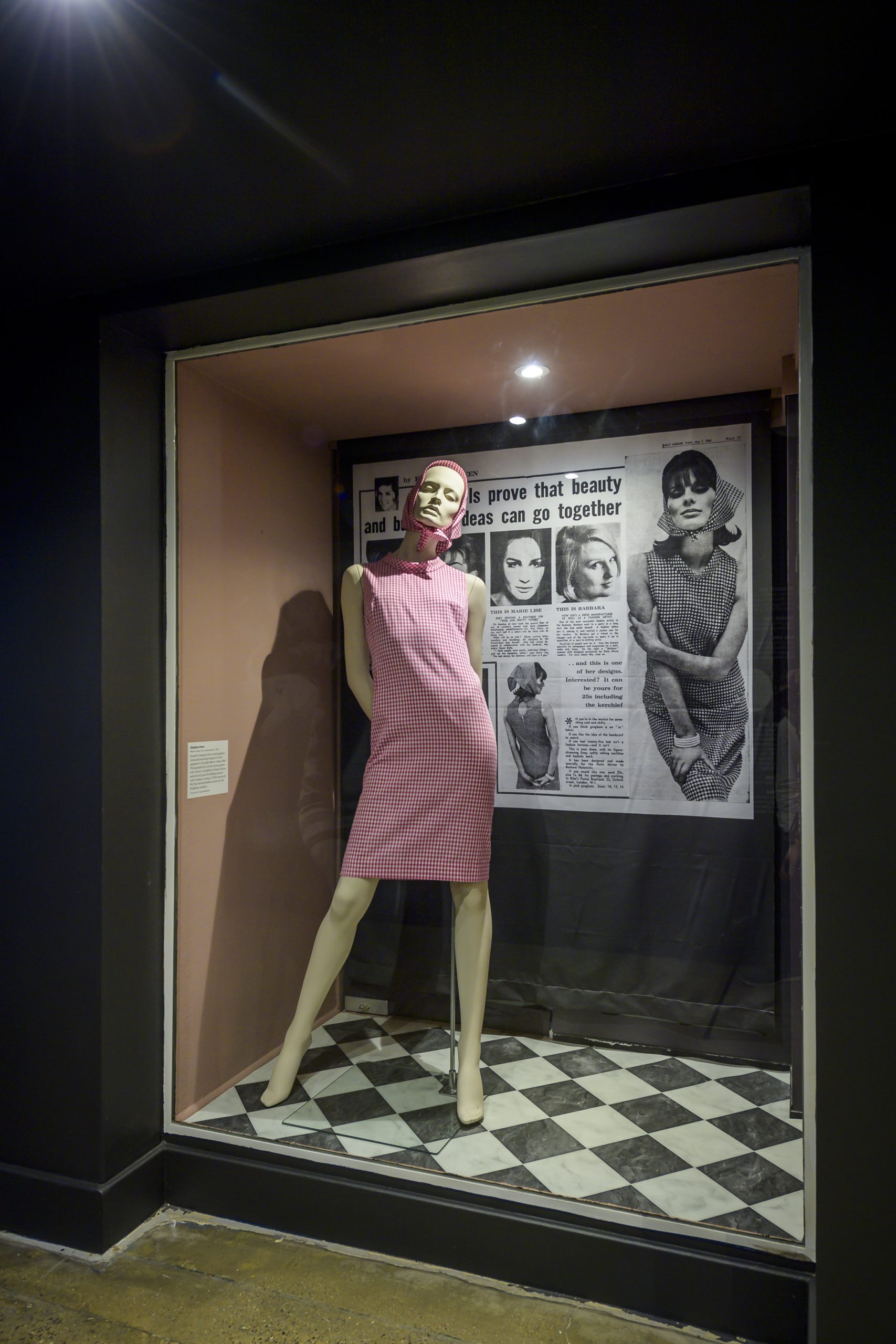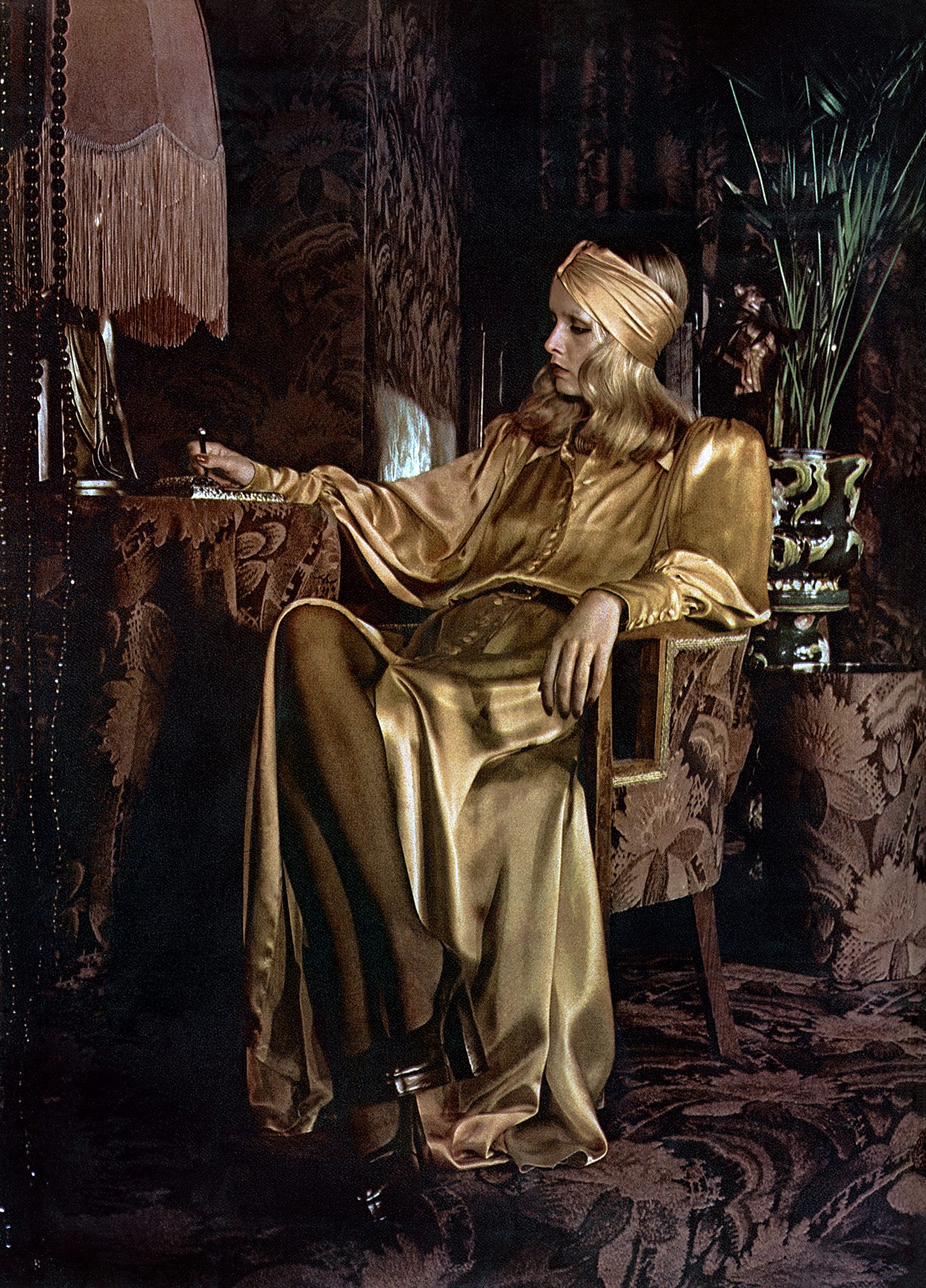Deborah Nash
Biba: A Legacy Lost and Found
The Biba Story, 1964-1975 at The Fashion and Textile Museum, 22 March – 8 September 2024.
.
.
Between 1963 and 1975, the seemingly unstoppable phenomenon that was Biba went from mail-order to boutique shop to department store to a seven-storey colossus, followed by the label’s sudden and complete disappearance from London’s Kensington High Street. I never went to a single Biba shop nor owned a single Biba item yet I always seem to have known the name, synonymous with rock, glamour, and all things 1960s.
.
A new exhibition at the Fashion and Textile Museum in Bermondsey seeks to bring out Biba’s legacy, throwing into sharp relief our present day high streets, emptied of thrills, fun and freshness. Visitors arriving at the museum doors may recall rifling through the treasures of one of the four Biba shops described in The Biba Story: 1964 – 1975. We walk past garments displayed on mannequins and grouped chronologically, evolving in cut and sophistication. As one boutique closed, another opened, bigger, better situated, and an expansion of the dream matched in bricks and mortar. Amongst attendees of the exhibition’s opening was Barbara Hulanicki, the founder of Biba. When asked what her favourite memory of the shops was, Hulanicki replies: “All the staff who worked there. It was fantastic fun and frightening fun!” It is that I am primed to experience that fun, drawn to the honey pot of collective nostalgia that has brought so many here.

The first item – almost a prologue at the start of the exhibition – is a pink gingham shift dress with a cut-out hole at the back and head scarf. It is – dare I say it – a little unremarkable, but in 1964 when the fashion journalist, Felicity Green, invited Hulanicki to design an outfit to be advertised in the Daily Mirror, orders flooded in by the mailsack load. Some 17,000 women wanted to wear pink gingham and think themselves into the glamour of the South of France where Brigitte Bardot had worn a similar garment. Priced at 25 shillings, they could afford to buy it. The success of this little gingham dress persuaded Hulanicki to give up freelancing as a fashion illustrator and devote herself to her fledgling business, with the help of her advertising exec husband, Stephen Fitz-Simon.
Among the early dresses from the Abingdon Road boutique is a pink and red minidress, long in the sleeve, short in the hemline with a Gothic motif print reminiscent of an Augustus Pugin wallpaper. It is typical of the Biba aesthetic in its combination of simple silhouette with patterns steeped in retro. Hulanicki’s inspirations – fleetingly touched on in this exhibition – included the sinuous lines and bejewelled shapes of Victorian illustrator Aubrey Beardsley); the feathered and flowered women in an Alphonse Mucha poster; the gilded showers of geometric patterns of a Gustav Klimt painting, and the stylised natural forms of George Rennie Mackintosh. The colours matched the work of these artists – bruised purples and plums, golds and silvers, rich blacks, earth browns and rust colours. “The silhouettes were as long as possible,” the designer has said, “like a drawing.” One of the label’s first logos uses Art Nouveau lettering and Celtic knot, which emblazoned T-shirts and totes on sale in the museum shop.
Unapologetically romantic, Biba differed from the futuristic space age of some 1960s fashion. I can picture its mystique: young girls dressed in unconventional murky hues and purple knee-high platform boots, striding down Kensington High Street like an ostentation of female dandies. This playfulness and peacockery were matched in menswear; suddenly, coloured shirts, frills and even dresses for men were in. Biba had its own take on male fashion, introduced at its Kensington Church Street shop. Displayed in the exhibition is a unisex cotton quilted jacket and trouser suit with a high collar, long zip down the middle and diagonal zips across the chest panels. Although described as a camouflage print, its pattern is more a mulch of autumnal leaf colours – coppery browns and mellow yellows – striking if worn by a couple promenading through a London park.
Other stand-out pieces are the leopard print coat and Hulanicki’s own grey leopard trouser suit from 1973. When her involvement in Biba came to an end, the designer kept this scoop-collared, pocket-flapped, trouser-flared, feline outfit and loaned it to the exhibition. I was also pleased to find a jacket and culottes made from fabric designed by Althea McNish in her trademark combo of hot, tropical hues. McNish created a range for Biba in 1967, and the scallop-shaped patterns of ‘Clouds’ pop in the layering of deep orange, mustard yellow and light violet.
Biba, from its inception, was always a veritable wonderland for art lovers; exotic bamboo palms sprouting from urns and dresses, hats and beads slung onto bent wooden hat stands against theatrical curtains, large mirrors and Art Nouveau wallpaper. There was charm, there was allure, and it spoke to a generation of women starting out in the world. “It was like walking into the Secret Garden,” said Twiggy, at the opening of the exhibition. Meanwhile, The Guardian reported in 1967 that “the skirts are shorter, the lights are dimmer than anywhere else in London”.

Shopping shifted to the level of theatre when the seven-storey building on Kensington High Street opened. With its Art Deco carvings on the façade and its famous roof garden, it must have felt a neat fit for the flamboyant opulence of Big Biba. Even the articulation of what it was brings a frisson of excitement: shoppers could sleep, eat, and breathe Biba, from stacks of canned baked beans and soup in Biba colours, displayed on shelves in giant tins of sardines or ham, and glass flacons of orchid water on the food floor to the Rainbow Room restaurant at the top, with its 1,200 covers, serving up clean food (no sauce) with live music from the likes of Liberace, the New York Dolls and the Pointer Sisters. Biba clothes may have been cheap, but the transformation of this emporium cost £14 million, a sum as extravagant as the store’s interiors and, Icarus-like, the brand began sinking beneath the weight of its own opulence. Following disagreements with their business partners, Hulanicki and Fitz-Simon walked away, eventually setting up an interior design business in Miami.
Hulanicki’s Biba had lasted just eleven years, but so much of its extraordinariness was not present in this exhibition. Where was the hedonistic abundance of sartorial treasures? I wanted to see more of everything and I wanted to see it displayed with the same energy and vision as in the original shops: more dresses on hangers and hatstands, heaps of T-shirts, vases of pastel-hued ostrich feathers, bangles and beads, mirrors and wallpapers and fringed lampshades that arrived at Biba’s zenith when the brand became lifestyle and brought glamour to the buying of butter. Where are the 1920s-style display mannequins? Where are the photographs of the rockstars in their best Biba garments – Cher, Jagger, Bowie, Bolan, Freddie Mercury? Where are the images of people of colour wearing the cosmetic range that Biba was the first to develop for their skin tones? How did they look?
Ultimately, this is an exhibition cobbled together from clothes loaned by private individuals, some more remarkable for having lasted so long than how they appeared on headless mannequins. The design and installation of the show failed to match the flare, dare and imagination of its founder, and some of its exhibits even looked gaudy. As our high streets struggle to survive changing shopping habits, brought by the pandemic, the rising cost of living and online purchasing, perhaps we need to revisit Biba’s spirit of playfulness, optimism and laughter – an opportunity unfortunately missed by this show.
.
.
.
Cover image: Twiggy in Biba rainbow room, 1971 ©Justin De Villeneuve/Iconic Images
.
Deborah Nash lives in Brighton. She studied visual art in Nanjing, China and Bourges, France, and now works as a freelance journalist for The FT, The New European, The Wire and Selvedge magazine, among others. Her theatre productions have been staged at Theatre503, The Arcola and The British Museum and her short stories appear in Litro, The Mechanic Institutes’ Review, Stand magazine and Ambit. Find her on Instagram @deborahnashhasted and https://www.whatmoreproductions.co.uk/
To discover more content exclusive to our print and digital editions, subscribe here to receive a copy of The London Magazine to your door every two months, while also enjoying full access to our extensive digital archive of essays, literary journalism, fiction and poetry.


You must be logged in to post a comment.